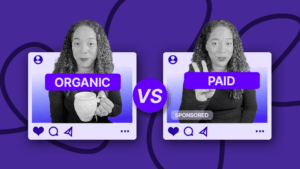From Hashtags to Sales: UGC Campaign Examples That Worked
Passionate content and search marketer aiming to bring great products front and center. When not hunched over my keyboard, you will find me in a city running a race, cycling or simply enjoying my life with a book in hand.
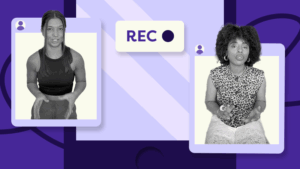
User-generated content (UGC) campaigns are reshaping how brands build trust and influence purchase decisions. In a world where authenticity trumps polish, seeing real customers share their honest experiences is more persuasive than any branded message.
Roughly 85% of consumers now believe that UGC is more impactful than brand-created visuals, while 92% trust peer reviews and testimonials over traditional advertising. That’s why UGC campaigns are generating 50% more engagement on social media and 73% higher clickthrough rates in emails. It’s not just more effective, it’s more believable.
What’s more, UGC doesn’t sleep. Once launched, it continues to drive visibility and conversions around the clock. From Coca-Cola’s personalized bottles to everyday creators sharing product stories, brands are using UGC to build loyal communities and boost revenue.
In this post, we’ll explore standout UGC campaign examples that prove just how powerful user content can be, from startups to iconic brands. You’ll also learn why these campaigns worked and how to replicate their success.
TL;DR
- Bluehouse Salmon grew social followers by 1900% with 500+ nano-influencer recipe videos.
- Royal Match used TikTok creators to boost visibility and app downloads with playful short-form content.
- FIGS’ #wearFIGS campaign engaged healthcare workers and earned 20M+ TikTok views.
- GoPro’s #GoProHero became iconic with 50M+ Instagram posts of customer adventures.
- Trivago’s #TrivagoFaves invited hotel photos, sparking travel engagement on Instagram.
- Glossier reposted customer selfies to drive loyalty and build an inclusive brand.
- National Geographic’s #WanderlustContest sourced stunning travel shots from real explorers.
- Calvin Klein’s #MyCalvins blended celebrity reach with global user participation.
- Moxy Hotels used real-world prompts to trigger 80K+ guest photo posts.
- Mercadona gained viral traction from a spontaneous pineapple-cart trend started by shoppers.
The power of UGC in modern marketing
When talking about UGC campaign examples in modern marketing, it’s easy to understand why they win over brand messaging. Instead of getting a polished message, users see their peers interacting with the product, using, and recommending it.
This plays on our psychology and makes it easier to trust the message compared to when it comes from actors or models. The main two drivers for using UGC campaigns are:
- Building trust and authenticity
- Driving engagement and community
Both powerful on their own and great when combined into a single initiative.
Having said that, let’s take a look at the most successful UGC campaign examples over the recent years.
Most Notable UGC Campaign Examples
1. Bluehouse Salmon’s educational content drive
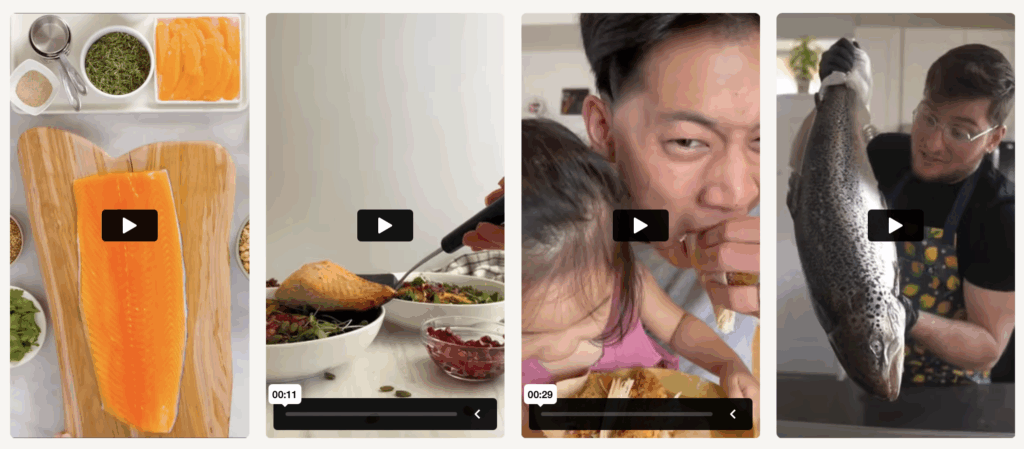
Campaign overview: In 2022, Bluehouse Salmon—a U.S.-based land-farmed salmon brand—partnered with inBeat Agency to launch a UGC campaign centered on education and healthy eating.
Strategy: The brand leveraged nano- and micro-influencers to produce authentic, recipe-based content that demonstrated how to cook with their product. By using real creators instead of polished ads, the campaign emphasized utility and trust.
Results: The effort delivered over 500 unique UGC assets and fueled a 1900% increase in Bluehouse Salmon’s social media following over 12 months. The strategy turned the brand into a resource, not just a product.
Key takeaway: Peer-led, educational UGC is a powerful lever for both awareness and brand authority—especially when scaled with trusted micro-influencers.
2. Royal Match’s influencer collaborations
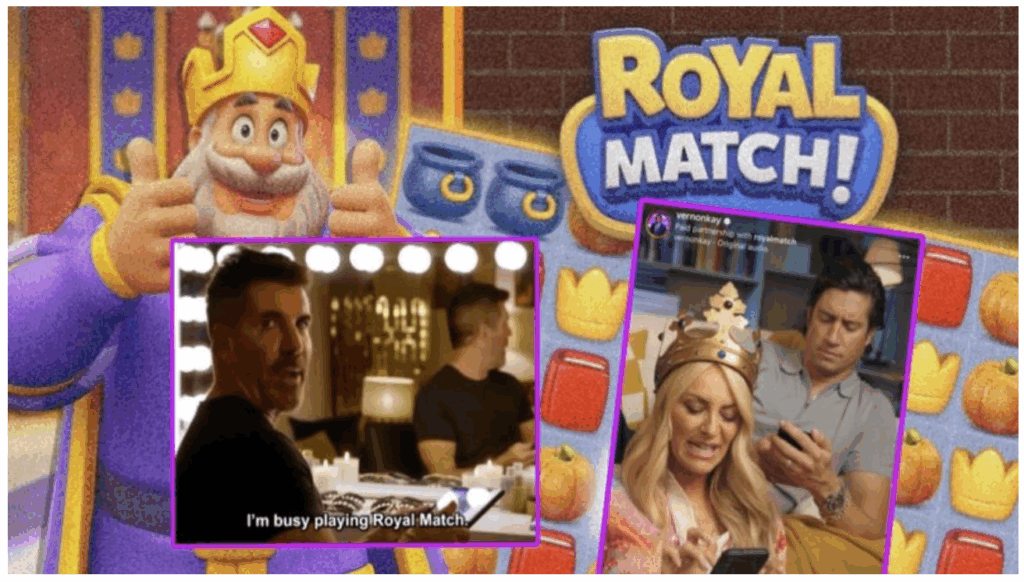
Campaign overview: In 2023, mobile game Royal Match launched a UGC-driven campaign by partnering with celebrities and influencers on TikTok to boost downloads and visibility.
Strategy: The brand tapped into creator relatability and entertainment value. By commissioning short-form videos that highlighted gameplay in humorous or dramatic ways, Royal Match made the content feel native to TikTok – while subtly driving interest in the app.
Results: The campaign racked up millions of views, increasing both awareness and user acquisition. As Esports.net reported, Royal Match’s use of celebrity influencers helped the game stand out in a crowded app marketplace by adding social credibility to its growth efforts.
Key takeaway: Entertainment-first UGC (especially when paired with the right influencers) can drive performance without feeling like a sales pitch.
3. FIGS’ #wearFIGS community engagement

Campaign overview: In 2021, healthcare apparel brand FIGS launched the #wearFIGS campaign, encouraging medical professionals to share real-life photos of themselves wearing FIGS scrubs.
Strategy: FIGS focused on user empowerment, spotlighting frontline workers through authentic storytelling. By promoting everyday heroes, the campaign resonated emotionally and reinforced the brand’s connection to its core audience.
Results: The hashtag quickly gained momentum, accumulating over 20 million views on TikTok and fueling a vibrant online community. As Creation.co noted, FIGS transformed its customers into brand advocates by simply giving them the stage.
Key takeaway: UGC that celebrates your audience (not just your product) can deepen loyalty and build movements, not just engagement.
4. GoPro’s #GoProHero adventure sharing
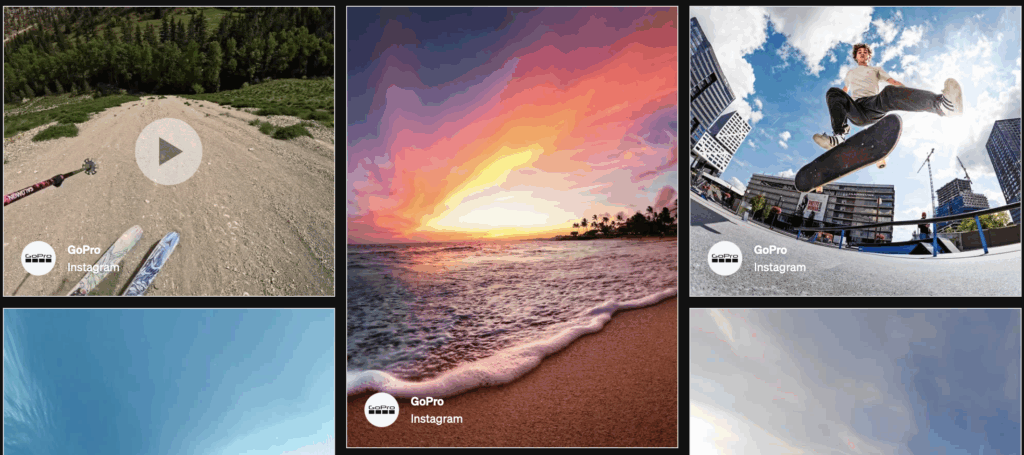
Campaign overview: Since 2014, GoPro has consistently invited users to share action-packed footage under its iconic #GoProHero campaign, showcasing real-life adventures through the lens of its cameras.
Strategy: The brand positioned its customers as creators. By encouraging them to post personal experiences – ski runs, skydives, surfing clips, GoPro turned buyers into content generators and brand ambassadors.
Results: The results speak volumes: over 50 million Instagram posts have used the #GoProHero tag, creating a near-limitless stream of authentic content. According to Wobb and GoPro’s own awards page, this UGC model didn’t just drive engagement, it became central to GoPro’s marketing identity.
Key takeaway: When your product empowers storytelling, UGC can become a self-sustaining engine of brand visibility and social proof.
5. SEMrush’s LinkedIn creator partnerships
Campaign overview: In 2023, SEMrush launched a LinkedIn-focused UGC campaign by partnering with professional creators who were already genuine users of their platform.
Strategy: Instead of using generic endorsements, SEMrush amplified authentic testimonials from marketing experts and SEO practitioners. These creators shared how SEMrush supported their work making the content both credible and deeply relevant to a professional audience.
Results: The campaign strengthened brand authority and expanded reach within the B2B space. According to SEMrush Academy, this creator-led approach boosted visibility and trust without resorting to overt product promotion.
Key takeaway: On professional platforms like LinkedIn, real-user advocacy outperforms polished ads. Especially when creators speak directly to peers with proof-backed experiences.
Creative UGC Campaigns Examples Across Industries
6. Trivago’s #TrivagoFaves photo contest

Campaign overview: In 2021, travel booking platform Trivago launched the #TrivagoFaves contest on Instagram, asking users to post photos of their favorite hotel stays listed on the site.
Strategy: By framing the campaign as a visual celebration of travel memories, Trivago tapped into positive emotions and wanderlust. The UGC not only showcased stunning destinations but also built trust through real traveler perspectives.
Results: The promotional video earned over 37,000 views, and the campaign boosted engagement on Instagram as users shared snapshots from across the globe (RafflePress).
Key takeaway: Travel is inherently visual and experiential – UGC campaigns that harness that can turn customers into credible storytellers for your brand.
8. Starbucks’ #WhiteCupContest artistic engagement
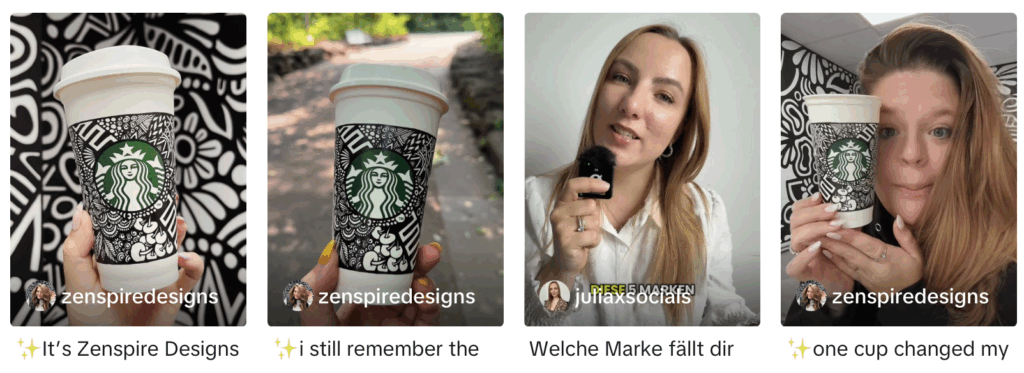
Campaign overview: Back in 2014, Starbucks launched the #WhiteCupContest, inviting customers to decorate its plain white coffee cups and share their designs on social media.
Strategy: The brand tapped into customer creativity, transforming a simple cup into a canvas. By turning everyday objects into shareable art, Starbucks encouraged participation that felt personal and expressive.
Results: The contest received nearly 4,000 entries in just three weeks. Even more impressively, it led to a 20% increase in reusable cup sales the following year, showing how creative engagement can drive sustainable behaviors (StoryBox).
Key takeaway: Creative prompts that invite personal expression can boost both brand engagement and product adoption, especially when users see their work celebrated.
9. Glossier’s customer-centric imagery
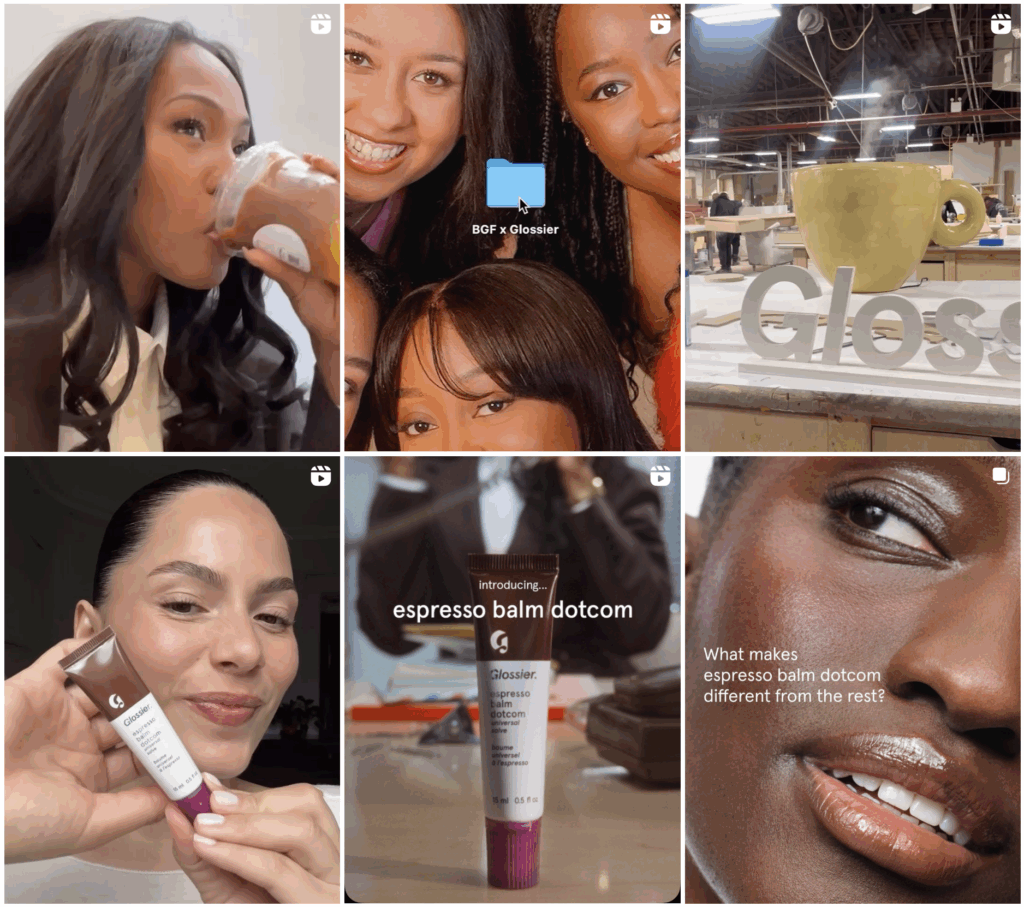
Campaign overview: Since its launch, Glossier has built its beauty brand by spotlighting real customers through photos and reviews across its digital channels.
Strategy: Instead of relying on professional models or heavily staged content, Glossier prioritized authentic, user-generated visuals. By reposting selfies, testimonials, and everyday skincare routines, the brand positioned customers as its most powerful marketers.
Results: This approach fueled community loyalty and helped Glossier grow into a cult favorite. As Extole reports, the brand’s word-of-mouth strategy, rooted in UGC, became a cornerstone of its success.
Key takeaway: Centering real customers in your brand imagery doesn’t just build trust, it turns fans into influential brand advocates.
10. National Geographic’s #WanderlustContest
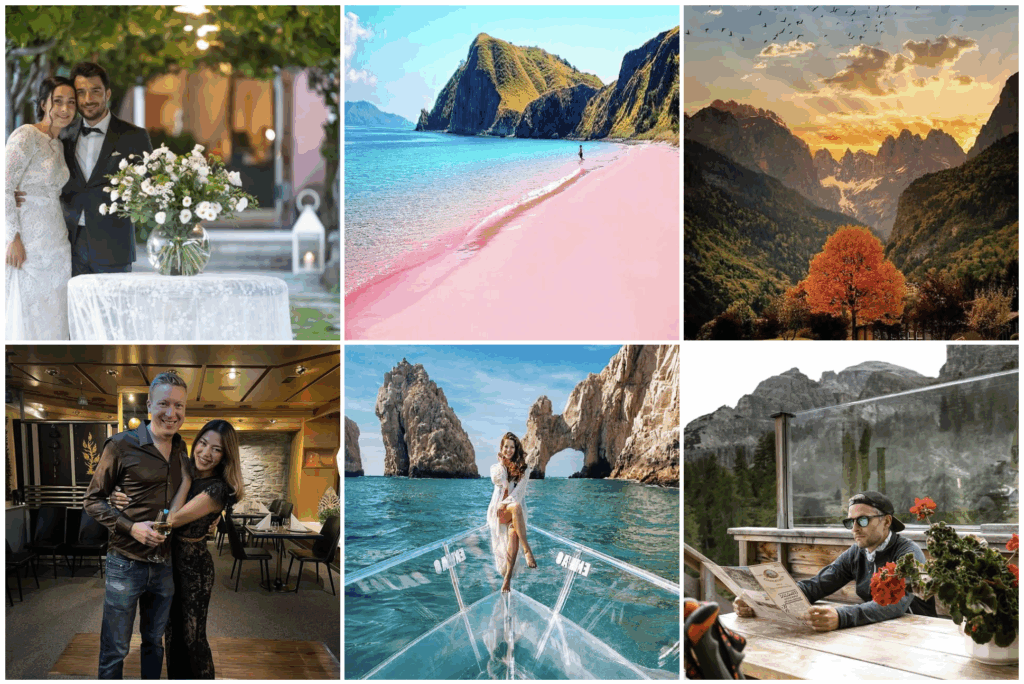
Campaign overview: National Geographic launched the #WanderlustContest to encourage travelers to share their most inspiring travel photos for a chance to win a photo expedition.
Strategy: By appealing to its audience’s passion for exploration and storytelling, National Geographic curated a campaign that felt aspirational yet accessible. The content reflected the brand’s ethos while giving users a platform to shine.
Results: The campaign generated a wealth of stunning, shareable content and amplified engagement among travel and photography enthusiasts. It successfully deepened brand affinity through community-driven visuals.
Key takeaway: When your audience aligns deeply with your brand’s mission, UGC campaigns can serve both engagement and editorial excellence.
11. Calvin Klein’s #MyCalvins social movement
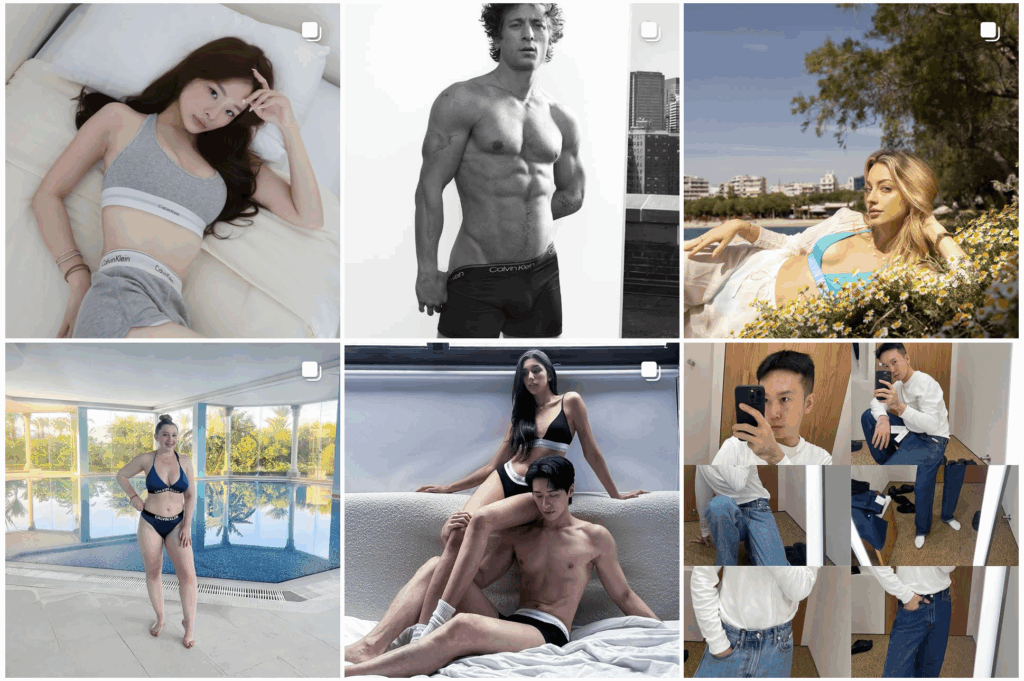
Campaign overview: Calvin Klein’s ongoing #MyCalvins campaign blends celebrity influence with everyday participation, encouraging users to share photos wearing the brand’s apparel.
Strategy: The brand smartly combined aspirational content from high-profile ambassadors with authentic user submissions. This dual approach allowed Calvin Klein to maintain prestige while building community through mass engagement.
Results: The campaign generated over 190,000 Instagram posts using the #MyCalvins hashtag. As Interview Magazinenotes, the campaign helped redefine brand loyalty by giving fans the chance to be seen alongside celebrities—on the same platform and under the same banner.
Key takeaway: Pairing mass visibility with grassroots participation can scale brand impact without losing authenticity.
12. Moxy Hotels’ #AtTheMoxy physical activations
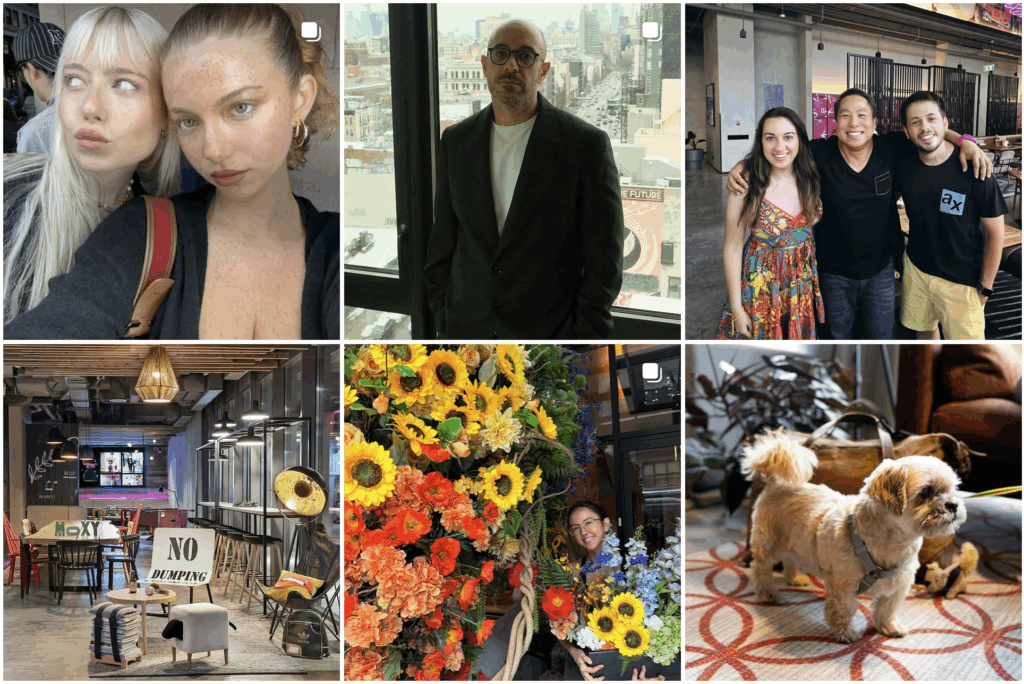
Campaign overview: Moxy Hotels brought user-generated content offline and into real-world spaces by placing stickers and prompts in mirrors, elevators, and other high-traffic areas to encourage guests to post photos with the hashtag #AtTheMoxy.
Strategy: These physical cues transformed everyday hotel moments into social opportunities. The playful, branded prompts made it easy and natural for guests to create and share content during their stay.
Results: The campaign generated over 80,000 tagged images, significantly boosting brand visibility and positioning Moxy as a youthful, share-worthy hospitality brand (Likefriends).
Key takeaway: Real-world prompts can bridge the gap between physical experiences and digital engagement turning guests into instant creators.
Lessons from Iconic UGC Campaign Examples
From emotional storytelling to unexpected virality, the best UGC campaigns prove that authenticity drives results—especially when it comes from real people. Dove’s “Real Beauty Sketches” struck an emotional chord by spotlighting the gap between how women see themselves and how others see them. With over 163 million views, the campaign showed that vulnerability and realness can create global impact.
Sport England’s “This Girl Can” followed a similar path, choosing relatability over perfection. By showcasing ordinary women participating in fitness without glamorization, the campaign redefined who fitness is for and inspired 2.8 million women to get active. In contrast, the EepyBird duo’s viral Diet Coke and Mentos experiment, while entirely unbranded, boosted sales for both products. Demonstrating that spontaneous fan-led UGC can be just as powerful when brands stay open and reactive.
Lessons learned:
- Emotionally honest storytelling earns deep engagement and loyalty.
- Featuring real people (not actors) amplifies credibility and reach.
- Unplanned or fan-led UGC can drive massive visibility and business impact when embraced by the brand.
Strategies for Launching a Successful UGC Campaign
Launching a UGC campaign is one thing, launching one that delivers real results is another. These proven strategies will help you build campaigns that not only attract content, but also drive meaningful engagement and brand growth.
- Set clear objectives and KPIs. Defining goals helps you measure performance and guide decision-making.
- Choose the right platforms. Reaching your audience where they already spend time increases participation.
- Create a compelling campaign theme. A relatable theme sparks interest and makes content creation easier for users.
- Offer incentives to participate. Rewards like contests or features give users a reason to engage and share.
- Use branded hashtags. Hashtags help unify campaign content and make it easier to discover.
- Moderate and curate submissions. Filtering content ensures quality and protects your brand image.
- Showcase user content across channels. Featuring UGC builds trust and encourages future contributions.
- Track results and optimize. Monitoring KPIs reveals what works and where to improve.
- Keep engaging your community post-campaign. Ongoing interaction builds loyalty and keeps the content flywheel turning.
UGC Campaign Examples Final Thoughts
User-generated content campaigns aren’t just a marketing trend, they’re a proven strategy for building trust, driving conversions, and cultivating brand loyalty. The most effective campaigns combine clear strategy with authentic storytelling and active community involvement. From massive influencer activations to spontaneous trends, UGC proves that real voices create real impact.
If you’re ready to turn user content into high-performing campaigns, start by setting clear goals, choosing the right platforms, and tapping into the stories your audience is already sharing. And when you need help scaling fast with creators who deliver, Billo is built to make that easy.
FAQs
What makes a UGC campaign successful?
A successful UGC campaign invites authentic participation, aligns with audience interests, offers clear incentives, and amplifies the best content across multiple channels. Recognition and ongoing engagement help sustain momentum.
How do brands come up with ideas for UGC campaigns?
Ideas often come from customer behavior, feedback, or cultural trends. Effective campaigns are usually simple, emotionally resonant, and easy to participate in—like contests, hashtag prompts, or creative challenges.
What are the potential risks of UGC campaigns?
Risks include copyright issues, off-brand content, or negative feedback. These can be avoided with clear content guidelines, proactive moderation, and securing proper user permissions.
How do you measure the success of a UGC campaign?
Key metrics include engagement rates, reach, content volume, hashtag use, conversions, and community sentiment. Success also includes qualitative signals like loyalty and brand advocacy.
SEO Lead
Passionate content and search marketer aiming to bring great products front and center. When not hunched over my keyboard, you will find me in a city running a race, cycling or simply enjoying my life with a book in hand.

Authentic creator videos, powered by real performance data
22,000+ brands use Billo to turn UGC into high-ROAS video ads.
Common UGC Brief Mistakes Brands Still Make in...
A vague or overpacked brief derails campaigns before they start, [...]...
Read full articleOrganic UGC vs Paid UGC: How Top Brands Drive Gr...
More brands are turning to user-generated content (UGC) to fuel [...]...
Read full articleOrganic UGC: How to Turn Native Creator Posts in...
Short-form feeds spotlight content that feels natural, not like ads. [...]...
Read full article


